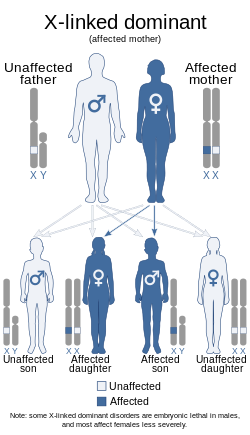Focal dermal hypoplasia

Editor-In-Chief: Prab R Tumpati, MD
Obesity, Sleep & Internal medicine
Founder, WikiMD Wellnesspedia &
W8MD medical weight loss NYC and sleep center NYC
| Focal dermal hypoplasia | |
|---|---|

| |
| Synonyms | Goltz syndrome, Goltz-Gorlin syndrome |
| Pronounce | |
| Specialty | Medical genetics |
| Symptoms | Skin abnormalities, skeletal malformations, eye defects, dental issues |
| Complications | N/A |
| Onset | Congenital |
| Duration | Lifelong |
| Types | N/A |
| Causes | Mutations in the PORCN gene |
| Risks | |
| Diagnosis | Clinical diagnosis, genetic testing |
| Differential diagnosis | Incontinentia pigmenti, Ectodermal dysplasia |
| Prevention | N/A |
| Treatment | Symptomatic treatment, surgical intervention |
| Medication | |
| Prognosis | N/A |
| Frequency | Rare |
| Deaths | |
Focal dermal hypoplasia is a rare genetic disorder that primarily affects the skin, skeleton, eyes, and face. The condition is also known as Goltz syndrome.

Symptoms[edit]
The symptoms of focal dermal hypoplasia are highly variable and can include skin abnormalities, skeletal abnormalities, and eye abnormalities. Some individuals may also have facial abnormalities and intellectual disability.
Skin Abnormalities[edit]
The skin abnormalities associated with focal dermal hypoplasia are present at birth and can include patches of thin, wrinkled skin, areas of hyperpigmentation and hypopigmentation, and small clusters of blood vessels just under the skin.
Skeletal Abnormalities[edit]
Skeletal abnormalities can include short stature, scoliosis, and abnormalities of the hands and feet, such as syndactyly (fusion of the fingers or toes) or polydactyly (extra fingers or toes).
Eye Abnormalities[edit]
Eye abnormalities can include microphthalmia (small eyes), coloboma (a hole in the eye), and strabismus (crossed eyes).
Facial Abnormalities[edit]
Facial abnormalities can include a small, pointed chin, a flat nasal bridge, and a cleft or split in the upper lip (cleft lip) or palate (cleft palate).
Causes[edit]
Focal dermal hypoplasia is caused by mutations in the PORCN gene. This gene provides instructions for making a protein that is involved in the development of many tissues and organs before birth.
Diagnosis[edit]
The diagnosis of focal dermal hypoplasia is based on the presence of characteristic symptoms. Genetic testing can confirm the diagnosis.
Treatment[edit]
There is currently no cure for focal dermal hypoplasia. Treatment is aimed at managing the symptoms and can include surgery to correct skeletal abnormalities, skin care to manage skin abnormalities, and special education services for those with intellectual disability.
See also[edit]
- Genetic disorders
- Skin disorders
- Skeletal disorders
- Eye disorders
- Facial disorders
- http://www.orpha.net/consor/www/cgi-bin/OC_Exp.php?lng=EN&Expert=2092
- GeneReview/NIH/UW entry on Focal dermal hypoplasia
| X-linked disorders |
|---|
|
|
Ad. Transform your life with W8MD's Budget GLP-1 injections from $75


W8MD offers a medical weight loss program to lose weight in Philadelphia. Our physician-supervised medical weight loss provides:
- Weight loss injections in NYC (generic and brand names):
- Zepbound / Mounjaro, Wegovy / Ozempic, Saxenda
- Most insurances accepted or discounted self-pay rates. We will obtain insurance prior authorizations if needed.
- Generic GLP1 weight loss injections from $75 for the starting dose.
- Also offer prescription weight loss medications including Phentermine, Qsymia, Diethylpropion, Contrave etc.
NYC weight loss doctor appointmentsNYC weight loss doctor appointments
Start your NYC weight loss journey today at our NYC medical weight loss and Philadelphia medical weight loss clinics.
- Call 718-946-5500 to lose weight in NYC or for medical weight loss in Philadelphia 215-676-2334.
- Tags:NYC medical weight loss, Philadelphia lose weight Zepbound NYC, Budget GLP1 weight loss injections, Wegovy Philadelphia, Wegovy NYC, Philadelphia medical weight loss, Brookly weight loss and Wegovy NYC
|
WikiMD's Wellness Encyclopedia |
| Let Food Be Thy Medicine Medicine Thy Food - Hippocrates |
Medical Disclaimer: WikiMD is not a substitute for professional medical advice. The information on WikiMD is provided as an information resource only, may be incorrect, outdated or misleading, and is not to be used or relied on for any diagnostic or treatment purposes. Please consult your health care provider before making any healthcare decisions or for guidance about a specific medical condition. WikiMD expressly disclaims responsibility, and shall have no liability, for any damages, loss, injury, or liability whatsoever suffered as a result of your reliance on the information contained in this site. By visiting this site you agree to the foregoing terms and conditions, which may from time to time be changed or supplemented by WikiMD. If you do not agree to the foregoing terms and conditions, you should not enter or use this site. See full disclaimer.
Credits:Most images are courtesy of Wikimedia commons, and templates, categories Wikipedia, licensed under CC BY SA or similar.
Translate this page: - East Asian
中文,
日本,
한국어,
South Asian
हिन्दी,
தமிழ்,
తెలుగు,
Urdu,
ಕನ್ನಡ,
Southeast Asian
Indonesian,
Vietnamese,
Thai,
မြန်မာဘာသာ,
বাংলা
European
español,
Deutsch,
français,
Greek,
português do Brasil,
polski,
română,
русский,
Nederlands,
norsk,
svenska,
suomi,
Italian
Middle Eastern & African
عربى,
Turkish,
Persian,
Hebrew,
Afrikaans,
isiZulu,
Kiswahili,
Other
Bulgarian,
Hungarian,
Czech,
Swedish,
മലയാളം,
मराठी,
ਪੰਜਾਬੀ,
ગુજરાતી,
Portuguese,
Ukrainian


